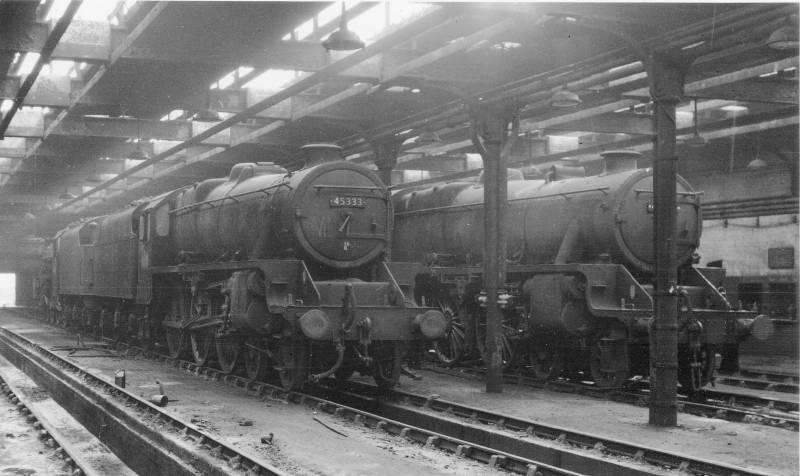- LMS Stanier Class 5 4-6-0
Infobox Locomotive
powertype=Steam
name = LMS Stanier Class 5 4-6-0
caption = 45333 and 44665 inside Annesley shed on11 September 1965 . 45333 has a domed boiler, whilst 44665 has one of the later Ivatt forward top-feed type boilers.
designer =William Stanier
builder = LMSCrewe Works
LMSDerby Works LMSHorwich Works Vulcan Foundry Armstrong Whitworth (327)
builddate = 1934-1951
totalproduction = 842
whytetype =4-6-0
uicclass = 2'Ch
gauge = RailGauge|ussg
leadingsize = convert|39.5|in|m|3|abbr=on
driversize = convert|72|in|m|3|abbr=on
length = 63 ft 7¾ in or 63 ft 11¾ in
weight = convert|72.2|LT|t|1 to convert|75|LT|t|1
fueltype = Coal
fuelc
convert|9|LT|t|1
waterc
convert|4000|impgal|l|abbr=on|lk=on
cylindercount = Two, outside
cylindersize = 18½×26 in (470×660 mm)
valvegear = Most Walschaerts, some outside Stephenson or Caprotti
boiler=LMS type 3B
firearea = convert|27.75|sqft|abbr=on or convert|28.5|sqft|abbr=on
fireboxarea = convert|156|sqft|abbr=on or convert|171|sqft|abbr=on
boilerpressure = convert|225|psi|MPa|2|abbr=on|lk=on superheated
tractiveeffort = convert|25455|lbf|kN|2|abbr=on|lk=on
railroadclass=LMS: 5P5F
BR: 5MT
retiredate=1961–1968 TheLondon Midland and Scottish Railway 's Class 5 4-6-0, almost universally known as the Black Five, is a class ofsteam locomotive . It was introduced byWilliam Stanier in 1934 and 842 were built between then and 1951. Members of the class survived to the last day of steam onBritish Railways , in 1968 and eighteen are preserved.Origins
The Black Fives were a
mixed traffic locomotive, a "do-anything go-anywhere" type, designed by Stanier, who had previously been with the GWR. In his early LMS days he designed his Stanier Mogul 2-6-0 in which he experimented with the GWR school of thought on Locomotive design. A number of details in this design he would never use again realising the superiority of details not used on the GWR. But Stanier realised that there was a need for larger locomotives. These were to be the LMS's version of the GWR Halls. They shared similar cylinder arrangement (two outside), internal boiler design and size and 6 footdriving wheel diameters.Construction
There were a number of detail variations in the locomotives, and they did not all remain in the same condition as built. Some locomotives built under British Railways administration were used as test beds for various design modifications with a view to incorporating the successful modifications in the Standard Classes of locomotives built from 1951 onwards. These modifications included outside
Caprotti valve gear , roller bearings (both Timken and Skefco types) on the coupled and tender axles in varying combinations and an experimental steel firebox. Other locomotives had modified draughting to "self clean" the smokebox (thereby reducing turn-around and disposal times, and eliminating, or mitigating, one of the most unpopular jobs).The domeless engines
Numbering started from 5000, with the first twenty being ordered from
Crewe Works and a further eighty from theVulcan Foundry . The first to emerge was the first Vulcan Foundry engine, 5020, in 1934; the first Crewe-built engine, 5000 not completed until 1935. The originals were built with domeless, straight throatplate boilers with low degree superheat (14 elements). However, many received later type boilers later in their lives.The prewar domed engines
A further 227 were ordered from
Armstrong-Whitworth in 1936, the largest single locomotive order ever given by a British railway to an outside contractor. Crewe built a further 142. These had domed high degreesuperheat boilers.5471, built at Crewe in 1938 would be the last built for five years. During the early stages of the
Second World War the priority was for heavy freight engines and the closely-related 8Fs were produced in vast numbers.Wartime and postwar domed engines
In 1943 construction was restarted with
Derby Works building its first. However, after number 5499 was built, the numbering block hit that of the Patriot Class, and so new engines were numbered from 4800 onwards. However, after another 200 were built they again ran out of numbers, so they started numbering below 4800. By this time, the LMS had been nationalised intoBritish Railways and BR added 40000 to all their numbers. Eventually the 842 examples would number 44658-45499.Ivatt engines and experimental modifications
Post-war examples were built with forward topfeeds. In 1948
George Ivatt introduced more modifications to bearings and valve gear. 4767 was built with Stephenson link motion in 1947. 44738-57 were built withCaprotti valve gear . The last two, 44686 and 44687 built at Horwich in 1951, had even more modifications.Sound
*
In fiction
In
The Railway Series of children's books by the Rev. W. Awdry, the character "Henry the Green Engine ", in his later form, is based on a Black Five.cite book
last =The Rev. W.
first =Awdry
authorlink = W.V. Awdry
co-authors= G Awdry
title =
publisher =Kaye & Ward
date =1987
pages =(p129)
id =ISBN 0 434 92762 7 ]ee also
*
BR standard class 5 References
External links
* http://www.semgonline.com/visitor/visitor_6.html#45349
* http://rileysontour.fotopic.net/
* http://black5photos.co.uk/
Wikimedia Foundation. 2010.
